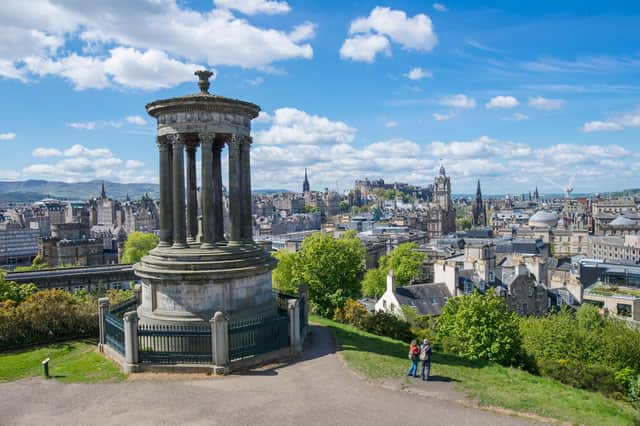Vision revealed for Edinburgh Architecture Centre to help shape city's future


Now the Scottish capital could be set to boast its own architecture centre under a drive to build consensus about how its landscape should evolve in future.
A taskforce has been created to pursue the vision of an Edinburgh Architecture Centre to bring together the city’s architects, planners, heritage bodies, city leaders and the people of Edinburgh for the first time.
Advertisement
Hide AdAdvertisement
Hide AdKey aims include helping to avoid the kind of damaging disputes that have engulfed major projects in modern times and ensuring Edinburgh realises its ambition of becoming a net zero carbon city by 2030.
It is hoped the centre will become a focal point for public debate, play host to a permanent exhibition on Edinburgh’s evolution, and showcase plans for new developments and possible future visions of the city.
Edinburgh University, the Royal Incorporation of Architects in Scotland, Architecture and Design Scotland, Edinburgh World Heritage, the Scottish Government and the city council have all been involved in drawing up initial plans for the centre.
It is likely to take a “pop-up” form in a public building or empty shop unit while plans for a more permanent centre are developed.
Advertisement
Hide AdAdvertisement
Hide AdThe original idea for the centre was put forward by the leading Edinburgh architect Rab Bennetts, who said similar concepts in Hamburg, Amsterdam and Copenhagen had encouraged the development of “a positive design culture which has helped to create liveable, enjoyable places where new and old co-exist very well”.
Bennetts said: “The intention is that something of this kind will act as a catalyst for engagement and collaboration, not only between the public authorities, heritage groups, architects and developers but also with the general public. It is important that it comes across as non-institutional and highly accessible.
“It should be the ‘go to’ place for everything to do with architecture and the built environment in Edinburgh.
“Through good communication, enthusiasm and greater transparency, a much clearer vision and consensus for the city’s future should be possible.Edinburgh is in the fortunate position of being an expanding city, so it has reason to be optimistic about a better future.
Advertisement
Hide AdAdvertisement
Hide Ad“A good example would be the council’s ambition for zero carbon. It is a really important policy and will affect many aspects of our lives, from new buildings and existing heritage to transport. There needs to be some kind of forum to debate and display what’s required.
“There’s no lack of potential in Edinburgh, but the public needs to be engaged and excited by good creative ideas.
“Similarly, the council and developers could make this facility an essential part of the public consultation processes, well before the planning application stage.”
Bennetts suggested that an under-used or “inefficient” building in Edinburgh city centre could be home to the venture to help get it off the ground.
Advertisement
Hide AdAdvertisement
Hide AdHe added: “This could work in an existing public building or maybe an empty retail unit but the principle is to be realistic about viability from the beginning or it won’t get off the ground.
“The members of the working group have enormous cumulative experience and have already helped to fund a feasibility study on viability.
“When the lockdown is over we need to move up a gear and identify a location, so we can then focus on ongoing costs and a programme of activity.
“It’s an extremely exciting prospect and everyone I have talked to is positive about it, subject always to viability. I’m convinced it would improve Edinburgh in the long term.”
Advertisement
Hide AdAdvertisement
Hide AdNicholas Hotham, head of external relations at Edinburgh World Heritage, said: “The subject of Edinburgh’s architecture – both the conservation of what needs protecting, and the design and approval of what is still to be built – is at the heart of our identity as a city.”
He added: “In any future space or forum for debate and public engagement, we’d therefore support an approach which integrates architecture with other strands and themes, such as our response to the climate emergency, the need for equitable inclusive economic growth, and the health and wellbeing of our residents.”
A message from the Editor:
Thank you for reading this article on our website. While I have your attention, I also have an important request to make of you.
With the coronavirus lockdown having a major impact on many of our advertisers - and consequently the revenue we receive - we are more reliant than ever on you taking out a digital subscription.
Advertisement
Hide AdAdvertisement
Hide AdSubscribe to scotsman.com and enjoy unlimited access to Scottish news and information online and on our app. With a digital subscription, you can read more than 5 articles, see fewer ads, enjoy faster load times, and get access to exclusive newsletters and content.
Visit www.scotsman.com/subscriptions now to sign up.
Our journalism costs money and we rely on advertising, print and digital revenues to help to support them. By supporting us, we are able to support you in providing trusted, fact-checked content for this website.
Joy Yates
Editorial Director
Comment Guidelines
National World encourages reader discussion on our stories. User feedback, insights and back-and-forth exchanges add a rich layer of context to reporting. Please review our Community Guidelines before commenting.